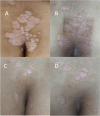Excimer light effect on neurogenic inflammation in active versus stable psoriasis lesions
- PMID: 38296870
- PMCID: PMC10830591
- DOI: 10.1007/s10103-024-04005-2
Excimer light effect on neurogenic inflammation in active versus stable psoriasis lesions
Abstract
Neurogenic inflammation, mediated by T helper 17 cell (Th17) and neurons that release neuropeptides such as substance P (SP), is thought to play a role in the pathogenesis of psoriasis. Excimer light is used in the treatment of psoriasis via induction of T cell apoptosis. The objective of this study is to study the effect of excimer light on active versus stable psoriasis and investigate the levels of substance P and its receptor in both groups. The study included 27 stable and 27 active psoriatic patients as well as 10 matched healthy controls. Clinical examination (in the form of local psoriasis severity index (PSI) and visual analogue scale (VAS)) was done to determine disease severity, level of itching, and quality of life. Tissue levels of SP and neurokinin-1 receptor (NK-1R) were measured by ELISA before and after 9 excimer light sessions in 43 patients. A statistically significant lower levels of PSI and VAS were reached after therapy with no significant difference between the stable and active groups. The mean tissue levels of SP before therapy were significantly higher than the control group. Lower levels of SP and NK-1 receptor were found after treatment overall and in each group. Excimer therapy can be effective for both stable and active plaque psoriasis and this effect could be partly through its role on ameliorating the neurogenic inflammation.
Keywords: Excimer light; Neurogenic inflammation; Psoriasis; Substance P.
© 2024. The Author(s).
Conflict of interest statement
The authors declare no competing interests.
Figures



Similar articles
-
Study of substance P and its receptor neurokinin-1 in psoriasis and their relation to chronic stress and pruritus.Arch Dermatol Res. 2007 May;299(2):85-91. doi: 10.1007/s00403-007-0745-x. Epub 2007 Mar 17. Arch Dermatol Res. 2007. PMID: 17370082
-
Efficacy of 308-nm excimer light for Japanese patients with psoriasis.J Dermatol. 2009 Nov;36(11):579-82. doi: 10.1111/j.1346-8138.2009.00710.x. J Dermatol. 2009. PMID: 19878389
-
Comparison of the 308-nm excimer laser and a 308-nm excimer lamp with 311-nm narrowband ultraviolet B in the treatment of psoriasis.Br J Dermatol. 2005 Apr;152(4):750-4. doi: 10.1111/j.1365-2133.2005.06533.x. Br J Dermatol. 2005. PMID: 15840108
-
Role of NGF and neurogenic inflammation in the pathogenesis of psoriasis.Prog Brain Res. 2004;146:433-7. doi: 10.1016/S0079-6123(03)46027-5. Prog Brain Res. 2004. PMID: 14699978 Review.
-
Pruritus in psoriasis: An update.Eur J Pain. 2016 Jan;20(1):41-6. doi: 10.1002/ejp.768. Epub 2015 Sep 28. Eur J Pain. 2016. PMID: 26415584 Review.
References
-
- Works MG, Yin F, Yin CC, Yiu Y, Shew K, Tran T-T, Dunlap N, Lam J, Mitchell T, Reader J, Stein PL, D’Andrea A (2014) Inhibition of TYK2 and JAK1 ameliorates imiquimod-induced psoriasis-like dermatitis by inhibiting IL-22 and the IL-23/IL-17 axis. J Immunol 193(7):3278–3287. 10.4049/jimmunol.1400205 - PMC - PubMed
-
- Sandoval-Talamantes AK, Gómez-González BA, Uriarte-Mayorga DF, Martínez-Guzman MA, Wheber-Hidalgo KA, Alvarado-Navarro A (2020) Neurotransmitters, neuropeptides and their receptors interact with immune response in healthy and psoriatic skin. Neuropeptides 79:102004. 10.1016/j.npep.2019.102004 - PubMed
-
- Vilisaar J, Kawabe K, Braitch M, Aram J, Furtun Y, Fahey AJ, Chopra M, Tanasescu R, Tighe PJ, Gran B, Pothoulakis C, Constantinescu CS (2015) Reciprocal regulation of substance P and IL-12/IL-23 and the associated cytokines, IFNγ/IL-17: a perspective on the relevance of this interaction to multiple sclerosis. JNIP 10(3):457–467. 10.1007/s11481-015-9589-x - PMC - PubMed
MeSH terms
Substances
LinkOut - more resources
Full Text Sources
Medical

